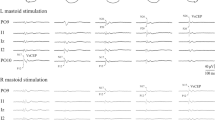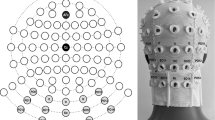Abstract
Vestibular cerebellar evoked potentials (VsCEPs) were recorded from over the occipital and cerebellar regions of the scalp using bone-conducted (BC) stimuli applied at the mastoids (impulsive accelerations and 500 Hz) and 500 Hz acoustic tones (AC). Ten healthy subjects were tested. Electrodes were positioned over the midline (Oz, Iz, CBz) and at 3, 6 and 9 cm intervals lateral to the midline electrodes bilaterally. Additional electrodes were also positioned over posterior neck muscles (SPL1 and SPL2). The largest evoked potentials on average were recorded from the electrodes 3 and 6 cm lateral to the Iz and CBz midline locations. BC stimuli produced short latency potentials on the side contralateral to the stimulated mastoid and were dependent on stimulus polarity. Positive polarity stimuli produced biphasic VsCEPs at approximately 12 and 17 ms (P12–N17) for BC impulses and 10 and 15 ms (P10–N15) for BC 500 Hz stimuli. Following the initial excitation, there was a period of suppression of background activity lasting an average of 16.8 ms for positive polarity BC impulses. Negative polarity stimuli produced later VsCEPs both for BC impulses (P20–N26) and BC 500 Hz (P13–N18). VsCEPs to AC 500 Hz stimuli lateralised to the contralateral side and were larger for right than left ear stimulation. Stimulus polarity (condensation and rarefaction) did not alter the timing of the VsCEPs to AC 500 Hz tones. No evoked response was recorded to somatosensory (median and radial nerve) stimulation. Four patients with cerebellar disease were tested and two showed abnormal VsCEPs with initial negativities. VsCEPs show distinct mapping over the posterior fossa and are likely to reflect climbing fibre responses via crossed otolith–cerebellar pathways.







Similar content being viewed by others
Change history
05 June 2020
In the original publication of the article, Fig.��3 is incorrect.
References
Albus JS (1971) A theory of cerebellar function. Math Biosci 10:25–61
Armstrong DM, Harvey RJ (1968) Responses of a spino-olivo-cerebellar pathway in the cat. J Physiol 194(147–168):1968
Barmack NH, Fagerson M, Ferdette BJ, Mugnaini E, Shoaku H (1993) Activity of neurons in the beta nucleus of the inferior olive of the rabbit evoked by natural vestibular stimulation. Exp Brain Res 94:203–215
Bickford RG, Jacobson JL, Cody DTR (1964) Nature of average evoked potentials to sound and other stimuli in man. Ann NY Acad Sci 112:204–218
Brodal P, Brodal A (1981) The olivocerebellar projection in the monkey. Experimental studies with the method of retrograde tracing of horseradish peroxidase. J Comp Neurol 201:375–393
Büttner-Ennever JA (1999) A review of otolith pathways to brainstem and cerebellum. Ann NY Acad Sci 871:51–64
Chihara Y, Iwasaki S, Ushio M, Murofushi T (2007) Vestibular-evoked extraocular potentials by air-conducted sound: Another clinical test for vestibular function. Clin Neurophysiol 118:2745–2751
Colebatch JG, Halmagyi GM, Skuse NF (1994) Myogenic potentials generated by a click-evoked vestibulocollic reflex. J Neurol Neurosurg Psychiatry 57:190–197
Curthoys IS, Kim J, McPhedran SK, Camp AJ (2006) Bone conducted vibration selectively activates irregular primary otolithic vestibular neurons in the guinea pig. Exp Brain Res 175:256–267
Curthoys IS, Vulovic V, Burgess AM, Sokolic L, Goonetilleke SC (2016) The response of guinea pig primary utricular and saccular irregular neurons to bone-conducted vibration (BCV) and air-conducted sound (ACS). Hear Res 331:131–143
Eccles JC, Provini L, Strata P, Táboříková H (1968) Analysis of electrical potentials evoked in the cerebellar anterior lobe by stimulation of hindlimb and forelimb nerves. Exp Brain Res 6:171–194
Fushiki H, Barmack NH (1997) Topography and reciprocal activity of cerebellar Purkinje cells in the uvula-nodulus modulated by vestibular stimulation. J Neurophysiol 78:3083–3094
Govender S, Rosengren SM, Todd NPM, Colebatch JG (2011) Ocular vestibular evoked myogenic potentials produced by impulsive lateral acceleration in unilateral vestibular dysfunction. Clin Neurophysiol 122:2498–2504
Govender S, Dennis DL, Colebatch JG (2015) Vestibular evoked myogenic potentials (VEMPs) evoked by air- and bone-conducted stimuli in vestibular neuritis. Clin Neurophysiol 126:2004–2013
Haines DE (2008) Neuroanatomy : an atlas of structures, sections, and systems, 7th edn. Wolters Kluwer Health, Philadelphia
Ito M, Yoshida M (1966) The origin of cerebellar-induced inhibition of Deiters neurones I Monosynaptic initiation of the inhibitory postsynaptic potentials. Exp Brain Res 2:330–349
Iwasaki S, McGarvie LA, Halmagyi GM, Burgess AM, Kim J, Colebatch JG, Curthoys IS (2007) Head taps evoke a crossed vestibulo-ocular reflex. Neurology 68:1227–1229
Janzen J, Schlindwein P, Bense S, Bauermann T, Vucurevic G, Stoeter P, Dieterich M (2008) Neural correlates of hemispheric dominance and ipsilaterality within the vestibular system. Neuroimage 42:1508–1518
Kheradmand A, Zee DS (2011) Cerebellum and Ocular Motor Control. Front Neurol 2:53
Latham A, Paul DH (1971) Spontaneous activity of cerebellar Purkinje cells and their responses to impulses in climbing fibres. J Physiol 213:135–156
Luo Y, Sugihara I (2016) The olivocerebellar tract. In: Gruol DL, Koibuchi N, Manto M, Molinari M, Schmahmann JD, Shen Y (eds) Essentials of cerebellum and cerebellar disorders. Springer, Basel, pp 55–61
Mauguière F, Allison T, Babiloni C, Buchner H, Eisen AA, Goodin DS, Jones SJ, Kakigi R, Matsuoka S, Nuwer M, Rossini PM, Shibasaki H (1999) Somatosensory evoked potentials. The International Federation of Clinical Neurophysiology. Electroencephalogr Clin Neurophysiol Suppl 52:79–90
McCormick DA, Thompson RF (1984) Cerebellum: essential involvement in the classically conditioned eyelid response. Science 80(223):296
Noohi F, Kinnaird C, DeDios Y, Kofman IS, Wood S, Bloomberg J, Mulavara A, Seidler R (2017) Functional brain activation in response to a clinical vestibular test correlates with balance. Front Syst Neurosci 11:11
Oldfield RC (1971) The assessment and analysis of handedness: the Edinburgh inventory. Neuropsychologia 9:97–113
Rosengren SM, Todd NPM, Colebatch JG (2005) Vestibular-evoked extraocular potentials produced by stimulation with bone-conducted sound. Clin Neurophysiol 116:1938–1948
Rosengren SM, Todd NPM, Colebatch JG (2009) Vestibular evoked myogenic potentials evoked by brief interaural head acceleration: properties and possible origin. J Appl Physiol 107:841–852
Rosengren SM, Govender S, Colebatch JG (2011) Ocular and cervical vestibular evoked myogenic potentials produced by air- and bone-conducted stimuli: Comparative properties and effects of age. Clin Neurophysiol 122:2282–2289
Rosengren SM, Weber KP, Govender S, Welgampola MS, Dennis DL, Colebatch JG (2019) Sound-evoked vestibular projections to the splenius capitis in humans: comparison with the sternocleidomastoid muscle. J Appl Physiol 126:1619–1629
Schlindwein P, Mueller M, Bauermann T, Brandt T, Stoeter P, Dieterich M (2008) Cortical representation of saccular vestibular stimulation: VEMPs in fMRI. Neuroimage 39:19–31
Todd NPM, Rosengren SM, Aw ST, Colebatch JG (2007) Ocular vestibular evoked myogenic potentials (OVEMPs) produced by air- and bone-conducted sound. Clin Neurophysiol 118:381–390
Todd NPM, Rosengren SM, Colebatch JG (2008) A source analysis of short-latency vestibular evoked potentials produced by air- and bone-conducted sound. Clin Neurophysiol 119:1881–1894
Todd NPM, Paillard AC, Kluk K, Whittle E, Colebatch JG (2014) Source analysis of short and long latency vestibular-evoked potentials (VsEPs) produced by left vs. right ear air-conducted 500 Hz tone pips. Hear Res 312:91–102
Todd NPM, Govender S, Colebatch JG (2017) The inion response revisited: evidence for a possible cerebellar contribution to vestibular-evoked potentials produced by air-conducted sound stimulation. J Neurophysiol 117:1000–1013
Todd NPM, Govender S, Colebatch JG (2018a) The human electrocerebellogram (ECeG) recorded non-invasively using scalp electrodes. Neurosci Lett 682:124–131
Todd NPM, Govender S, Colebatch JG (2018b) Vestibular cerebellar evoked potentials in humans and their modulation during optokinetic stimulation. J Neurophysiol 120:3099–3109
Todd NP, Govneder S, Colebatch JG (2019) Modulation of the human electro-cerebellogram (ECeG) during vestibular and optokinetic stimulation. Neurosci Lett 712:134497
Trouillas P, Takayanagi T, Hallett M, Currier RD, Subramony SH, Wessel K et al (1997) International Cooperative Ataxia Rating Scale for pharmacological assessment of the cerebellar syndrome. The Ataxia Neuropharmacology Committee of the World Federation of Neurology. J Neurol Sci 145:205–211
Ugawa Y, Uesaka Y, Terao Y, Hanajima R, Kanazawa I (1995) Magnetic stimulation over the cerebellum in humans. Ann Neurol 37:703–713
Walker MF, Tian J, Shan X, Tamargo RJ, Ying H, Zee DS (2010) The cerebellar nodulus/uvula integrates otolith signals for the translational vestibulo-ocular reflex. PLoS ONE 5:e13981
Wardman DL, Gandevia SC, Colebatch JG (2014) Cerebral, subcortical, and cerebellar activation evoked by selective stimulation of muscle and cutaneous afferents: an fMRI study. Physiol Rep 2:e00270
Watson SR, Colebatch JG (1998) Vestibulocollic reflexes evoked by short-duration galvanic stimulation in man. J Physiol 513(Pt 2):587–597
Welgampola MS, Rosengren SM, Halmagyi GM, Colebatch JG (2003) Vestibular activation by bone conducted sound. J Neurol Neurosurg Psychiatry 74:771–778
Acknowledgements
This work was supported by the Prince of Wales Hospital Foundation, SR1.
Author information
Authors and Affiliations
Corresponding author
Additional information
Communicated by Winston D Byblow.
Publisher's Note
Springer Nature remains neutral with regard to jurisdictional claims in published maps and institutional affiliations.
Rights and permissions
About this article
Cite this article
Govender, S., Todd, N.P.M. & Colebatch, J.G. Mapping the vestibular cerebellar evoked potential (VsCEP) following air- and bone-conducted vestibular stimulation. Exp Brain Res 238, 601–620 (2020). https://doi.org/10.1007/s00221-020-05733-x
Received:
Accepted:
Published:
Issue Date:
DOI: https://doi.org/10.1007/s00221-020-05733-x




